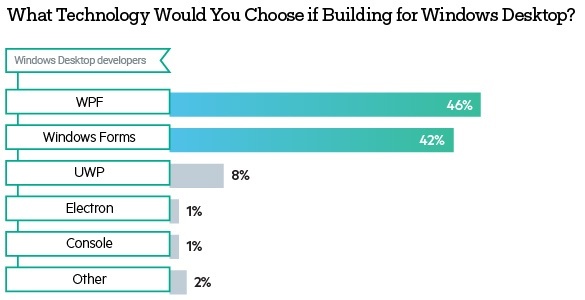Choosing the Right Technology for Your Next .NET Desktop Application
.png?sfvrsn=7a389d74_1)
Choosing the right technology for your desktop application project can be hard. We've created a short questionnaire to help you make an informed decision.
The Developer Dilemma
Developers often find themselves at a crossroads when choosing between various technologies and frameworks to use in a new desktop app project. StackOverflow is filled with threads on this topic, illustrating the conundrum developers often face when starting the development of a new application. Sometimes the project requirements can narrow down the options to only a few, or even, perhaps, a single one. However, there are cases in which a thorough evaluation is required in order to make the right decision.Last year, we surveyed over 1,000 .NET developers on topics ranging from technology adoption to favorite tools and learning habits. We also asked about trends and perceptions of the latest Microsoft technologies. It is obvious that when in comes to building Windows desktop applications, WPF and WinForms are the most popular technologies.

However, these results might exclude the project requirements and there are quite a few factors to be considered before drawing the line.
Making a Choice
There are various things to consider when picking the best technology to use for developing a desktop application. They include, but are not limited to:- What environment or OS are you targeting?
- How important is ease of development and the memory footprint?
- What is your budget for the project and what are the deadlines for production?
- How crucial is the stability of the applications?
- What development language do you and your team specialize in and feel comfortable with?
Additionally, developers have to consider factors such as framework sustainability and long term usability, the ease of setting up a build-environment to ensure an easy hand-off to other people maintaining the app, as well as documentation to help your developers get started.
In order to make the right decision, you first need to answer these questions for yourself and assess the possible options based on them. This topic is pretty massive and there is no one size fits all solution. Not only that, but as we are embracing the mobile-first mindset, you have to think about extending your desktop app experience towards other device families, such as phones or tablets.
Choosing the RIGHT Technology for Your Next .NET Desktop Application

Here at Progress, we have a long history with the .NET stack and the various technologies and frameworks revolving around it. Our mission has always been to empower developers and provide them with the right tools, whether UI or productivity, to enable faster and more robust application development. With that in mind, we felt the need to step in and help you solve the challenges you face in your day to day tasks.
We've created a short questionnaire to guide you in the right technology of choice for your next .NET desktop application. The questions are aimed at narrowing down the options and providing the best solution for your case. Based on your answers, we will suggest the best match of technology for you, backed up by a detailed overview, a comparison with alternative options and resources to kick-start your development.
Next Steps
We hope you find this survey useful—please feel free to reach out and let us know what you think in the comment section below!
Made up your mind on your go-to technology? Make sure to try out one of our UI toolkits. We offer support for every .NET tech:
- UI for WinForms
- UI for WPF
- UI for UWP
- UI for Xamarin
- Kendo UI (Electron)
- UI for NativeScript (JavaScript)
Happy coding!

Dobrin Grancharov
Dobrin is a Product Marketing Manager for the Desktop UI suites at Progress. He is passionate about trends and innovations in desktop application development, UI and UX. In his leisure time, Dobrin enjoys doing gymnastics, skiing, playing guitar and traveling the world. You can follow him on Twitter or get in touch through LinkedIn.
